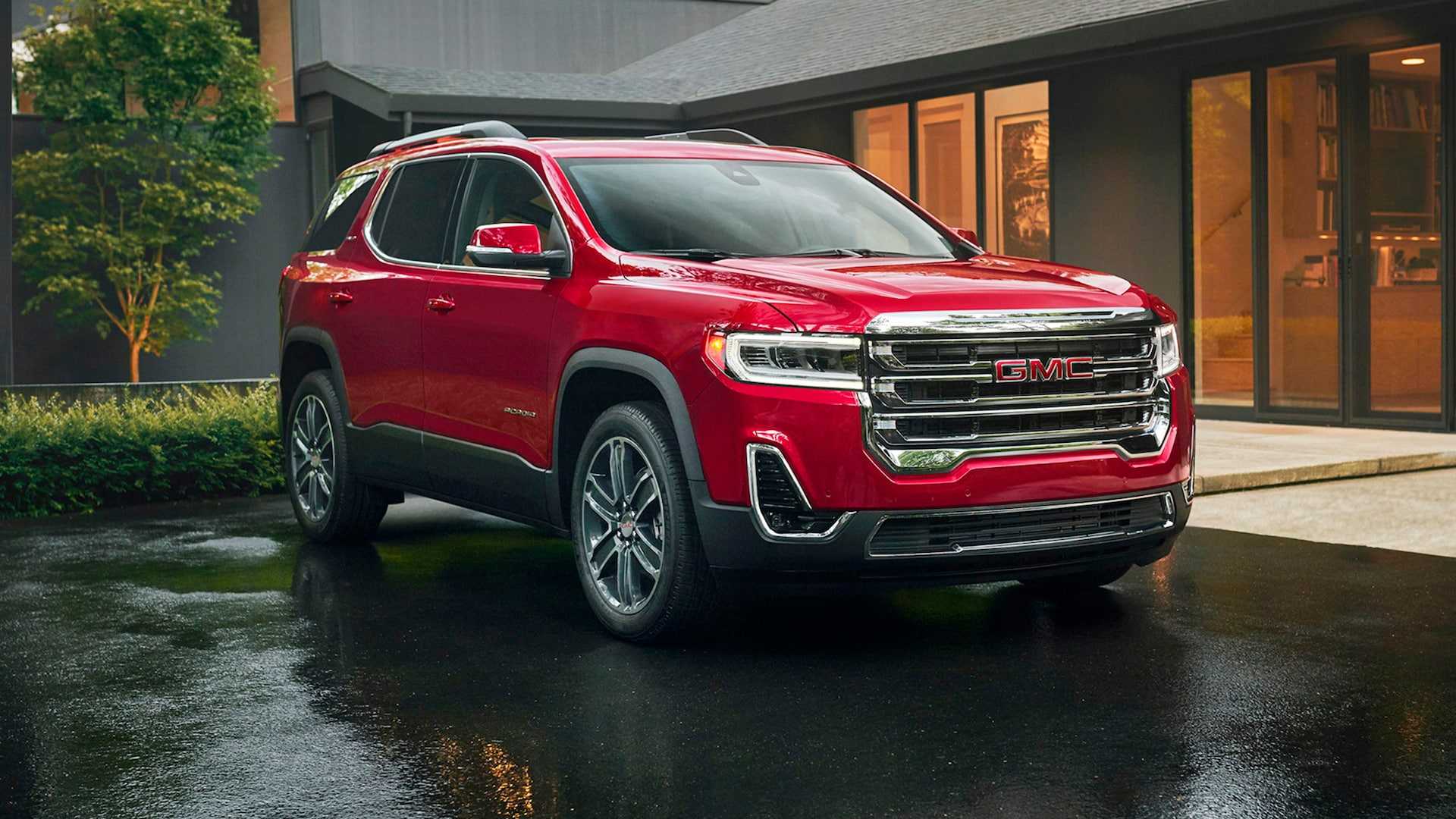GMC Acadia 2023 Ride and Cruise Control
Ride and Cruise Control features in the 2023 GMC Acadia provide a good balance of comfort and ease of use, making the driving experience better overall. The suspension system is controlled by Ride Control, which makes sure that the ride is smooth and stable whether you’re in the city or going off the beaten road. The Acadia is flexible enough to handle a variety of driving situations thanks to its adjustable suspension settings and ride height. On the other hand, Cruise Control makes long trips on the highway easier by letting drivers set and hold a speed, which means they don’t have to keep pressing the gas pedal. Adaptive Cruise Control is even available on some models. This feature changes the speed automatically to keep a safe following distance. All of these features in the Acadia work together to make driving more fun and stress-free, whether you’re going on a road trip or your daily commute.
2023 GMC ACADIA Specs, Price, Features and Mileage (Brochure)
Ride Control Systems
Traction Control/Electronic Stability Control
System Operation
The vehicle has a Traction Control System (TCS) and StabiliTrak/Electronic Stability Control (ESC), an electronic stability control system. These systems help limit wheel spin and assist the driver in maintaining control, especially on slippery road conditions. TCS activates if it senses that any of the drive wheels are spinning or beginning to lose traction. When this happens, TCS applies the brakes to the spinning wheels and reduces engine power to limit wheel spin. StabiliTrak/ESC activates when the vehicle senses a difference between the intended path and the direction the vehicle is actually traveling. StabiliTrak/ESC selectively applies braking pressure to any one of the vehicle wheel brakes to assist the driver in keeping the vehicle on the intended path. If cruise control is being used and TCS or StabiliTrak/ESC begins to limit wheel spin, cruise control will disengage. Cruise control may be turned back on when road conditions allow. TCS and StabiliTrak/ESC will automatically turn on when cruise control is set. Both systems come on automatically when the vehicle is started and begins to move. The systems may be heard or felt while they are operating or while performing diagnostic checks. This is normal and does not mean there is a problem with the vehicle. It is recommended to leave both systems on for normal driving conditions, but it may be necessary to turn TCS off if the vehicle gets stuck in sand, mud, ice, or snow.
The indicator light for both systems is in the instrument cluster. This light:
- Will flash when TCS is limiting wheel spin
- Will flash when StabiliTrak/ESC is activated
- Will turn on and stay on when either system is not working
- May flash when ABS is active
If either system fails to turn on or to activate, a message may display in the Driver Information Center (DIC), and d comes on and stays on to indicate that the system is inactive and is not assisting the driver in maintaining control. The vehicle is safe to drive, but driving should be adjusted accordingly.
If d comes on and stays on:
- Stop the vehicles.
- Turn the engine off and wait for 15
- Start the engine.
- Drive the vehicle.
- If d comes on and stays on, the vehicle may need more time to diagnose the problem. If the condition persists, see your dealer.
Turning the Systems Off and On
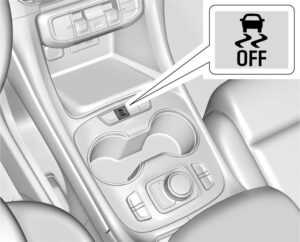
Caution
Do not repeatedly brake or accelerate heavily when TCS is off. The vehicle driveline could be damaged. To turn off only TCS, press, and release g. The Traction Off light i displays in the instrument cluster and a DIC message may display. To turn TCS on again, press and release g. The Traction Off light i displayed in the instrument cluster will turn off. If TCS is limiting wheel spin when g is pressed, the system will not turn off until the wheels stop spinning. To turn off both TCS and StabiliTrak/ESC, press and hold g until the Traction Off light i and StabiliTrak/ESC OFF light g come on and stay on in the instrument cluster. A DIC message may be displayed. To turn TCS and StabiliTrak/ESC on again, press and release g. The Traction Off light i and StabiliTrak/ESC OFF light g in the instrument cluster turn off. StabiliTrak will automatically turn on if the vehicle exceeds 56 km/h (35 mph). Traction control will remain off. Adding accessories can affect the vehicle’s performance.
Hill Descent Control (HDC)
If equipped, HDC can be used when driving downhill. It sets and maintains vehicle speed while descending a very steep incline in a forward or reverse gear. The HDC switch is on the center console. Press 5 to enable or disable HDC. Vehicle speed must be below 50 km/h (31 mph).
A blinking HDC light indicates the system is actively applying the brakes to maintain vehicle speed. HDC can maintain vehicle speeds between 3–22 km/h (2–14 mph) on an incline greater than or equal to a 10% grade. When HDC is activated, the initial HDC speed is set to the current driving speed. It can be increased or decreased by pressing the RES+ or SET– steering wheel controls or by applying the accelerator or brake pedal. This adjusted speed becomes the new set speed. HDC will remain enabled between 22– 60 km/h (14–37 mph); however, vehicle speed cannot be set or maintained in this range. It will automatically disable if the vehicle speed is above 80 km/h (50 mph) or above 60 km/h (37 mph) for at least 30 seconds. Press 5 again to re-enable HDC.
Driver Mode Control
If equipped, the Driver Mode Control has the following Modes: Tour (FWD), Sport, All-Wheel Drive (AWD), Snow, Tow/Haul, and Off-Road. Rotate the Driver Mode Control knob on the center console to make a mode selection. Continue turning the knob through the available modes. The selected mode’s icon will light up on the knob and there may be additional messages in the Driver Information Center (DIC) and indicators in the instrument cluster. If the vehicle is in Tour (FWD) or AWD, it will stay in that mode through future ON/ OFF cycles. If the vehicle is in any other mode, it will revert back to Tour (FWD) when the vehicle is restarted.
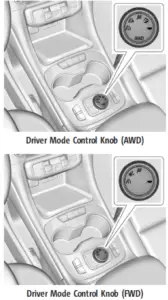
5 or q Tour (FWD): The vehicle is in Tour (FWD) mode. Use this mode during normal driving conditions. Tour (FWD) Mode operates in Front-Wheel Drive to improve fuel economy.
8 Sport: Sport mode improves vehicle handling and acceleration on dry pavement. When active, Sport mode modifies steering efforts, transmission shifting, and suspension tuning (when equipped). For AWD vehicles, choosing Sport mode also engages AWD mode. The Performance Algorithm Lift foot (PAL) feature is enabled in Sport mode. PAL allows the transmission to hold the current gear after a quick release of a heavily applied accelerator pedal. This provides greater engine braking and enhanced vehicle control.
4 AWD (AWD Only) : AWD mode provides drive torque to all four wheels. Select AWD to improve traction and control on slippery road surfaces, such as gravel, sand, wet pavement, snow, and ice. When in AWD mode, the AWD mode indicator will be on. The AWD mode will stay selected until the mode is changed AWD is active in AWD, Sport and Off-Road Modes. 6 Snow/Ice (FWD Only) : Snow/Ice mode improves vehicle acceleration on snow and ice-covered roads.
Tow/Haul: This feature can assist when towing a heavy load. Use this mode to assist in maintaining desired vehicle speeds when driving on downhill grades by using the engine and transmission. When active, the Tow/Haul mode modifies transmission shifting, suspension tuning, steering effort, and Trailer Sway Control. For AWD vehicles, choosing Tow/Haul mode also engages AWD.
Automatic engine-grade braking
Automatic engine-grade braking assists when driving downhill. It maintains vehicle speed by automatically implementing a shift pattern that uses the engine and the transmission to slow the vehicle. The system will automatically command downshifts to reduce vehicle speed. The normal shift pattern will return once the vehicle is on a low grade or when the accelerator pedal is pressed. While in the Electronic Range Select (ERS) mode, grade braking is deactivated, allowing the driver to select a range and limiting the highest gear available. Grade braking is available for normal driving and in Tow/ Haul mode.
7 Off-Road (AWD Only): Use this mode for off-road recreational driving. When active, the Off-Road mode modifies accelerator pedal response, ABS, TCS, steering effort, suspension tuning, and the StabiliTrak/ESC system. Choosing Off-Road mode also engages AWD mode. For more information on Off-Road mode,
Cruise Control
Warning
Cruise control can be dangerous when you cannot drive safely at a steady speed. Do not use cruise control on winding roads or in heavy traffic.
Warning (Continued)
Cruise control can be dangerous on slippery roads. On such roads, fast changes in tire traction can cause excessive wheel slip, and you could lose control. Do not use cruise control on slippery roads. With cruise control, a speed of about 40 km/h (25 mph) or more can be maintained without keeping your foot on the accelerator. Cruise control does not work at speeds below about 40 km/h (25 mph). If the StabiliTrak/Electronic Stability Control (ESC) system begins to limit wheel spin while using cruise control, the cruise control automatically disengages. If a collision alert occurs when cruise control is activated, cruise control is disengaged. When road conditions allow the cruise control to be safely used, cruise control can be turned back on. Turning off the TCS or StabiliTrak/ESC system will disengage the cruise control. If the brakes are applied, the cruise control disengages.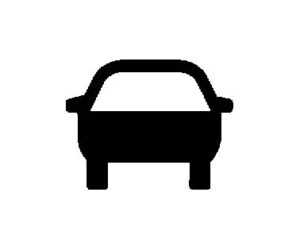
J: Press to turn the system on and off. A white indicator appears in the instrument cluster when the cruise is turned on.
RES+: If there is a set speed in memory, press briefly to resume to that speed or press and hold to accelerate. If the cruise control is already active, use it to increase vehicle speed.
SET−: Press briefly to set the speed and activate cruise control. If the cruise control is already active, use it to decrease vehicle speed.
- Press to disengage cruise control without erasing the set speed from memory.
Setting Cruise Control
If J is on when not in use, SET− or RES+ could get pressed and go into cruise when not desired. Keep J off when the cruise is not being used.
- Press J.
- Get up to the desired
- Press and release SET−. The desired set speed briefly appears in the instrument
- Remove your foot from the
When the cruise control has been set to the desired speed, a green cruise control indicator appears on the instrument cluster.
Resuming a Set Speed
If the cruise control is set at the desired speed and then the brakes are applied or * is pressed, the cruise control is disengaged without erasing the set speed from memory. Once the vehicle speed reaches about 40 km/h (25 mph) or more, press RES+ briefly. The vehicle returns to the previous set speed. Increasing Speed While Using Cruise Control
If the cruise control system is already activated:
- Press and hold RES+ up until the desired speed is reached, then release it.
- To increase vehicle speed in small increments, briefly press RES+. For each press, the vehicle goes about 1 km/h (1 mph) faster.
The speedometer reading can be displayed in either English or metric units. The increment value used depends on the units displayed.
Reducing Speed While Using Cruise Control
If the cruise control system is already activated:
- Press and hold SET− until the desired lower speed is reached, then release
- To decrease the vehicle speed in small increments, briefly press SET−. For each press, the vehicle goes about 1 km/h (1 mph) slower.
The speedometer reading can be displayed in either English or metric units. The increment value used depends on the units displayed.
Passing Another Vehicle While Using Cruise Control
Use the accelerator pedal to increase the vehicle speed. When you take your foot off the pedal, the vehicle will slow down to the previous set cruise speed. While pressing the accelerator pedal or shortly following the release to override the cruise, briefly applying SET− will result in the cruise set to the current vehicle speed.
Using Cruise Control on Hills
How well the cruise control will work on hills depends upon the vehicle’s speed, load, and the steepness of the hills. When going up steep hills, you might have to step on the accelerator pedal to maintain your speed. When going downhill, you may have to brake or shift to a lower gear to keep your speed down. If the brake pedal is applied, the cruise control disengages.
Ending Cruise Control
There are four ways to end cruise control:
- Step lightly on the brake
- Press *
- Shift the transmission to N (Neutral).
- Press J.
Erasing Speed Memory
The cruise control set speed is erased from memory if J is pressed or if the ignition is turned off.
Adaptive Cruise Control (Advanced)
If equipped with Adaptive Cruise Control (ACC), it allows the driver to select the cruise control set speed and following gap. Read this entire section before using this system. The following gap is the time between your vehicle and a vehicle detected directly ahead in your path, moving in the same direction. If no vehicle is detected in your path, ACC works like regular cruise control. ACC uses cameras and radar sensors. If a vehicle is detected in your path, ACC can apply acceleration or limited, moderate braking to maintain the selected following gap. To disengage ACC, apply the brake. If the ACC is controlling your vehicle speed when the Traction Control System (TCS) or StabiliTrak/Electronic Stability Control (ESC) system activates, the ACC may automatically disengage. When road conditions allow ACC to be safely used, the ACC can be turned back on. Disabling the TCS or StabiliTrak/ESC system will disengage and prevent the engagement of ACC. ACC can reduce the need for you to frequently brake and accelerate, especially when used on expressways, freeways, and interstate highways. When used on other roads, you may need to take over the control of braking or acceleration more often.
Warning
ACC has limited braking ability and may not have time to slow the vehicle down enough to avoid a collision with another vehicle you are following. This can occur when vehicles suddenly slow or stop ahead, or enter your lane. Also, Complete attention is always required while driving and you should be ready to take action and apply the brakes.
Warning
ACC will not detect or brake for children, pedestrians, animals, or other objects.
Do not use ACC when:
- On winding and hilly roads or when the sensors are blocked by snow, ice, or dirt. The system may not detect a vehicle ahead. Keep the entire front of the vehicle clean.
- Visibility is low, such as in fog, rain, or snow conditions. ACC performance is limited under these conditions.
- On slippery roads, fast changes in tire traction can cause excessive wheel slip.

- Press to turn the system on or off. The indicator turns white on the instrument cluster when ACC is turned on.
RES+: Press briefly to resume the previous set speed or to increase vehicle speed if ACC is already activated. To increase speed by 1 km/h (1 mph), briefly press RES+. To increase speed to the next 5 km/h (5 mph) mark on the speedometer, press and hold RES+, then release.
SET–: Press briefly to set the speed and activate ACC or to decrease vehicle speed if ACC is already activated. To decrease speed by 1 km/h (1 mph), briefly press SET−. To decrease speed to the next 5 km/h (5 mph) mark on the speedometer, press and hold SET−, then release.
- Press to disengage ACC without erasing the selected set speed.
- Press to select the following gap time (or distance) setting for ACC of Far, Medium, or Near.
Switching Between ACC and Regular Cruise Control
To switch between ACC and regular cruise control, press and hold *. A Driver Information Display (DIC) message is displayed. 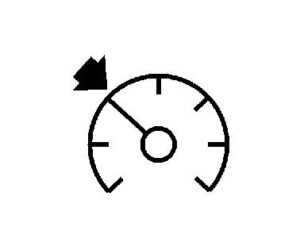
ACC Indicator

Regular Cruise Control
When ACC is engaged, a green ] indicator will be lit on the instrument cluster. When the regular cruise control is engaged, a green J indicator will be lit on the instrument cluster. When the vehicle is turned on, the cruise control mode will be set to the last mode used before the vehicle was turned off. It is recommended to switch from ACC to regular cruise control only, when there are no vehicles ahead of your vehicle.
Warning
Always check the cruise control indicator on the instrument cluster to determine which mode cruise control is in before using the feature. If ACC is not active, the vehicle will not automatically brake for other vehicles, which could cause a crash if the brakes are not applied manually. You and others could be seriously injured or killed.
Setting Adaptive Cruise Control
If J is on when not in use, it could get pressed and go into cruise when not desired. Keep J off when the cruise is not being used. Select the set speed desired for the cruise. This is the vehicle speed when no vehicle is detected in its path. ACC will not set at a speed less than 25 km/h (15 mph), although it can be resumed when driving at lower speeds. The minimum allowable set speed is 25 km/h (15 mph).
To set ACC:
- Press J.
- Get up to the desired speed.
- Press and release SET–.
- Remove foot from the accelerator.
After ACC is set, it may immediately apply the brakes if a vehicle ahead is detected closer than the selected following gap. ACC can also be set while the vehicle is stopped if ACC is on and the brake pedal is applied The ACC indicator displays on the instrument cluster and Head-Up Display (HUD), if equipped. When ACC is active, the indicator will be lit green. Be mindful of speed limits, surrounding traffic speeds, and weather conditions when selecting the set speed.
Resuming a Set Speed
If ACC is set at the desired speed and then the brakes are applied, ACC is disengaged without erasing the set speed from memory. To begin using ACC again, press RES+ up briefly.
- If the vehicle is moving more than 5 km/h (3 mph), it returns to the previous set
- If the vehicle is stopped with the brake pedal applied, press RES+ and release the brake pedal. ACC will hold the vehicle until RES+ or the accelerator pedal is
A green ACC indicator and the set speed display on the instrument cluster. The vehicle ahead indicator may be flashing if a vehicle ahead is present and moved. See “Approaching and Following a Vehicle” later in this section. Once ACC has resumed, if there is no vehicle ahead, if the vehicle ahead is beyond the selected following gap, or if the vehicle has exited a sharp curve, then the vehicle speed will increase to the set speed.
Increasing Speed While ACC is at a Set Speed
If ACC is already activated, do one of the following:
- Use the accelerator to get to a higher speed. Press SET–. Release the control and the accelerator pedal. The vehicle will now cruise at a higher speed.
When the accelerator pedal is pressed, ACC will not brake because it is overridden. While overridden, the ACC indicator will turn blue on the instrument cluster and heads-up display, if equipped.
- Press and hold RES+ until the desired set speed appears on the display, then release it.
- To increase vehicle speed in small increments, briefly press RES+. For each press, the vehicle goes 1 km/h (1 mph)
- To increase speed in larger increments, hold RES+. While holding RES+, the vehicle speed increases to the next 5 km/h (5 mph) step, then continues to increase by 5 km/h (5 mph) at a time.
The set speed can also be increased while the vehicle is stopped.
- If stopped with the brake applied, press RES+ until the desired set speed is
- If ACC is holding the vehicle at a stop and there is another vehicle directly ahead, pressing RES+ will increase the set speed. Pressing RES+ when there is no longer a vehicle ahead will cause ACC to resume.
When it is determined that there is no vehicle ahead or the vehicle ahead is beyond the selected following gap, then the vehicle speed will increase to the set speed. Reducing Speed While ACC is at a Set Speed
If ACC is already activated, do one of the following:
- Use the brake to get to the desired lower speed. Press SET– down and release the accelerator pedal. The vehicle will now cruise at a lower speed.
- Press and hold SET– until the desired lower speed is reached, then release it.
- To decrease the vehicle speed in smaller increments, briefly press SET−. For each press, the vehicle goes about 1 km/h (1 mph) slower.
- To decrease the vehicle speed in larger increments, hold SET−. While holding SET−, the vehicle speed decreases to the next 5 km/h (5 mph) step, then continues to decrease by 5 km/h (5 mph) at a time.
The set speed can also be decreased while the vehicle is stopped.
- If stopped with the brake applied, press or hold SET− until the desired set speed is displayed.
Selecting the Follow Distance Gap
When a slower-moving vehicle is detected ahead within the selected following gap, ACC will adjust the vehicle’s speed and attempt to maintain the follow distance gap selected. Press [ on the steering wheel to adjust the following gap. Each press cycles the gap button through three settings: Far, Medium, or Near. When pressed, the current gap setting displays briefly on the instrument cluster and HUD, if equipped. The gap setting will be maintained until it is changed. Since each gap setting corresponds to the following time (Far, Medium, or Near), the following distance will vary based on vehicle speed. The faster the vehicle speed, the further back your vehicle will follow a vehicle detected ahead. Consider traffic and weather conditions when selecting the following gap. The range of selectable gaps may not be appropriate for all drivers and driving conditions. Changing the gap setting automatically changes the alert timing sensitivity (Far, Medium, or Near) for the Forward Collision Alert (FCA) feature.
Alerting the Driver
If ACC is engaged, driver action may be required when ACC cannot apply sufficient braking because of approaching a vehicle too rapidly. When this condition occurs, the collision alert symbol will flash on the windshield. Either eight beeps will sound from the front, or both sides of the Safety Alert Seat will pulse five times. Touch the Settings icon on the infotainment home page. Select “Vehicle” to display the list of available options and select “Collision/Detection Systems”.
Approaching and Following a Vehicle

The vehicle ahead indicator is in the instrument cluster and HUD is equipped. The vehicle ahead indicator only displays when a vehicle is detected in your vehicle’s path moving in the same direction. If this symbol is not displaying, ACC will not respond to or brake for vehicles ahead. ACC automatically slows the vehicle down and adjusts vehicle speed to follow the vehicle in front at the selected follow gap. The vehicle speed increases or decreases to follow the vehicle in front of you, but will not exceed the set speed. It may apply limited braking, if necessary. When braking is active, the brake lights will come on. The automatic braking may feel or sound different than if the brakes were applied manually. This is normal.
Passing a Vehicle While Using the ACC
If the set speed is high enough, and the left turn signal is used to pass a vehicle ahead in the selected following gap, ACC may assist by gradually accelerating the vehicle prior to the lane change.
Warning
When using ACC to pass a vehicle or perform a lane change, the following distance to the vehicle being passed may be reduced. ACC may not apply sufficient acceleration or braking when passing a vehicle or performing a lane change. Always be ready to manually accelerate or brake to complete the pass or lane change.
Stationary or Very Slow-Moving Objects
Warning
ACC may not detect and react to stopped or slow-moving vehicles ahead of you. For example, the system may not brake for a vehicle it has never detected moving. This can occur in stop-and-go traffic or when a vehicle suddenly appears due to a vehicle ahead changing lanes. Your vehicle may not stop and could cause a crash. Use caution when using ACC. Your complete attention is always required while driving and you should be ready to take action and apply the brakes.
Irregular Objects Affecting ACC
ACC may have difficulty detecting the following objects:
- Vehicles with cargo extending from the back end.
- Non-standard shaped vehicles, such as vehicle transport, vehicles with a sidecar fitted, or horse carriages.
- Objects that are close to the front of your
ACC Automatically Disengages
ACC may automatically disengage and the driver will need to manually apply the brakes to slow the vehicle when:
- The sensors are
- The Traction Control System (TCS) or StabiliTrak/ESC system has activated or been disabled.
- There is a fault in the
- The radar may falsely report a blockage when driving in a desert or remote area with no other vehicles or roadside
- A DIC message may display to indicate that ACC is temporarily unavailable.
The ACC indicator will turn white when the ACC is no longer active. In some cases, when ACC is temporarily unavailable, regular cruise control may be used. See “Switching Between ACC and Regular Cruise Control” in this section. Always consider driving conditions before using either cruise control system.
Notification to Resume ACC
ACC will maintain a following gap behind a detected vehicle and slow your vehicle to a stop behind that vehicle. If the stopped vehicle ahead has driven away and ACC has not resumed, the vehicle ahead indicator will flash as a reminder to check traffic ahead before proceeding. In addition, the left and right sides of the Safety Alert Seat will pulse three times, or three beeps will sound. Touch the Settings icon on the infotainment home page. Select “Vehicle” to display the list of available options and select ”Alert Type” and “Adaptive Cruise Go Notifier” in “Collision/ Detection Systems”. When the vehicle ahead drives away, ACC resumes automatically if the stop was brief. Press RES+ or the accelerator pedal to resume cruise control. If stopped for more than two minutes or if the driver door is opened and the driver seat belt is unbuckled, the ACC automatically applies the Electric Parking Brake (EPB) to hold the vehicle. The EPB status light will turn on. To resume ACC and release the EPB, press the accelerator pedal. A DIC warning message may display indicating to shift to P (Park) before exiting the vehicle.
Warning
If ACC has stopped the vehicle, and if ACC is disengaged, turned off, or canceled, the vehicle will no longer be held at a stop. The vehicle can move. When ACC is holding the vehicle at a stop, always be prepared to manually apply the brakes.
Warning
Leaving the vehicle without placing it in P (Park) can be dangerous. Do not leave the vehicle while it is being held at a stop by ACC. Always place the vehicle in P (Park) and turn off the ignition before leaving the vehicle.
ACC Override
If using the accelerator pedal while ACC is active, the ACC indicator turns blue on the instrument cluster and HUD, if equipped. ACC will resume operation when the accelerator pedal is not being pressed
Warning
The ACC will not automatically apply the brakes if your foot is resting on the accelerator pedal. You could crash into a vehicle ahead of you.
Curves in the Road
Warning
On curves, ACC may not detect a vehicle ahead in your lane. You could be startled if the vehicle accelerates up to the set speed, especially when following a vehicle exiting or entering exit ramps. You could lose control of the vehicle or crash. Do not use ACC while driving on an entrance or exit ramp. Always be ready to use the brakes if necessary.
Warning
On curves, ACC may respond to a vehicle in another lane, or may not have time to react to a vehicle in your lane. You could crash into a vehicle ahead of you, or lose control of your vehicle. Give extra attention in curves and be ready to use the brakes if necessary. Select an appropriate speed while driving in curves. ACC may operate differently in a sharp curve. It may reduce the vehicle speed if the curve is too sharp. ACC automatically slows the vehicle down while navigating the curve and may increase speed out of the curve, but will not exceed the set speed.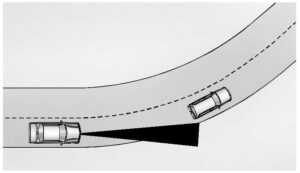
When following a vehicle and entering a curve, ACC may not detect the vehicle ahead and accelerate to the set speed. When this happens, the vehicle ahead indicator will not appear.
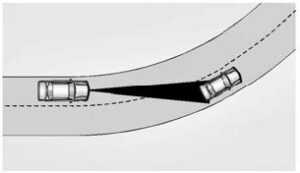
ACC may detect a vehicle that is not in your lane and apply the brakes. ACC may occasionally provide an alert and/ or braking that is considered unnecessary. It could respond to vehicles in different lanes, signs, guardrails, and other stationary objects when entering or exiting a curve. This is a normal operation. The vehicle does not need service.
Other Vehicle Lane Changes
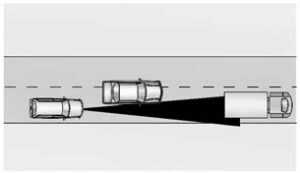
ACC will not detect a vehicle ahead until it is completely in the lane. The brakes may need to be manually applied. Objects Not Directly in Front of Your Vehicle.
The detection of objects in front of the vehicle may not be possible if:
- The vehicle or object ahead is not within your lane.
- The vehicle ahead is shifted, not centered, or is shifted to one side of the lane.
Driving in Narrow Lanes
Vehicles in adjacent traffic lanes or roadside objects may be incorrectly detected when located along the roadway.
Do Not Use ACC on Hills and When Towing a Trailer
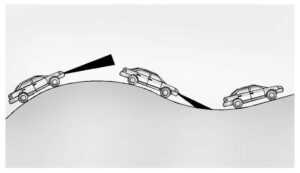
Do not use ACC when driving on steep hills or when towing a trailer. ACC will not detect a vehicle in the lane while driving on steep hills. The driver will often need to take over acceleration and braking on steep hills, especially when towing a trailer. If the brakes are applied, the ACC disengages. Disengaging ACC
There are three ways to disengage ACC:
- Step lightly on the brake pedal.
- Press *.
- Press J.
Erasing Speed Memory
The cruise control set speed is erased from memory if J is pressed or if the ignition is turned off. Weather Conditions Affecting ACC System operation may be limited under snow, heavy rain, or road spray conditions.
Accessory Installations and Vehicle Modifications
Do not install or place any object around the front camera windshield area that would obstruct the front camera view. Do not install objects on top of the vehicle that overhang and obstruct the front camera, such as a canoe, kayak, or other items that can be transported on a roof rack system. Do not modify the hood, headlamps, or fog lamps, as this may limit the camera’s ability to detect an object.
Cleaning the Sensing System
The camera sensor on the windshield behind the rearview mirror and the radar sensors on the front of the vehicle can become blocked by snow, ice, dirt, or mud. These areas need to be cleaned for ACC to operate properly. For cleaning instructions, System operation may also be limited under snow, heavy rain, or road spray conditions.
FAQ
The 2023 GMC Acadia is equipped with a sophisticated suspension system that includes MacPherson struts in the front and a five-link rear suspension for a smooth and comfortable ride.
Yes, the 2023 GMC Acadia offers an available Adaptive Ride Control system. This system continuously monitors road conditions and adjusts the suspension in real-time to provide optimal comfort and handling.
Yes, the 2023 GMC Acadia offers selectable drive modes, including Touring, Sport, Off-Road, and Tow/Haul. These modes adjust various vehicle settings, including the ride control, to match your preferred driving style or road conditions.
The 2023 GMC Acadia features a standard cruise control system. It allows you to set a desired speed, and the vehicle will maintain that speed until you manually override it or apply the brakes.
Yes, the 2023 GMC Acadia offers an available Adaptive Cruise Control system. This system uses sensors and radar technology to maintain a set distance from the vehicle ahead. It can automatically adjust the vehicle’s speed to match traffic conditions.
Yes, the Adaptive Cruise Control system in the 2023 GMC Acadia can bring the vehicle to a complete stop if traffic conditions require it. When the traffic ahead starts moving again, the system can resume following the vehicle ahead.
Yes, the 2023 GMC Acadia’s cruise control system includes a speed limiter function. This allows you to set a maximum speed limit that the vehicle will not exceed, providing an additional level of control.
Yes, the 2023 GMC Acadia’s Adaptive Cruise Control system typically offers multiple distance settings. You can choose a shorter or longer following distance based on your preference and traffic conditions.
Yes, the 2023 GMC Acadia’s cruise control system includes a resume function. If you’ve previously set a speed and disengaged the cruise control, you can press the resume button to return to that set speed.
Yes, you can cancel the cruise control in the 2023 GMC Acadia by either pressing the cancel button or applying the brakes.
Yes, the 2023 GMC Acadia offers an available Lane Keep Assist with Lane Departure Warning system. It can help you stay in your lane by providing gentle steering inputs and alerts if you unintentionally drift out of your lane.
While the specific capabilities may vary, some advanced adaptive cruise control systems in the 2023 GMC Acadia can include pedestrian and cyclist detection. These systems use cameras and sensors to identify potential obstacles
Useful Link
View Full User Guide: GMC Acadia 2023 User Guide
Download Manuals: https://www.cadillac.com/support/vehicle/manuals-guides
2023 GMC ACADIA Specs, Price, Features and Mileage (Brochure)

